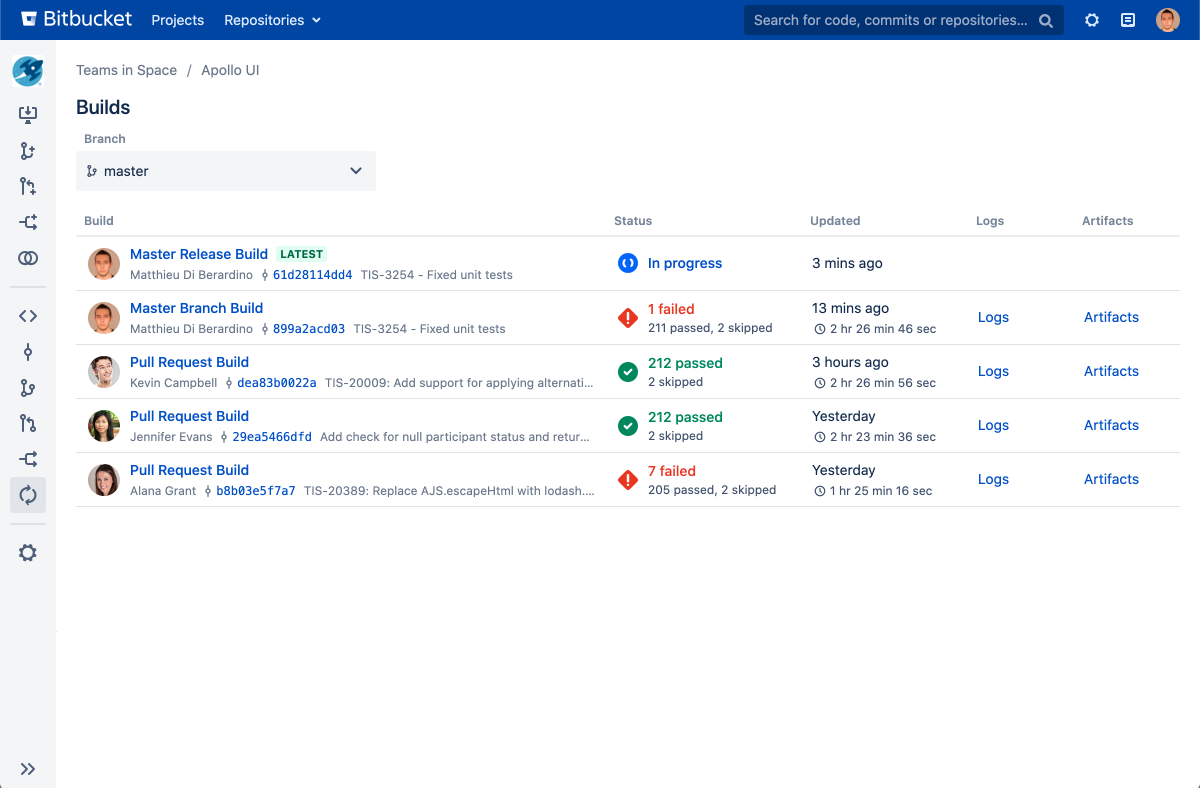Bamboo integration
When you integrate Bitbucket Server with Atlassian's Bamboo build and deployment server, commit, branch, build and deployment information is shared for users of both applications.
On this page:
Benefits of integration
When Bamboo and Bitbucket Data Center are integrated, you and your team get all the following advantages:
Bitbucket Data Center tells Bamboo when to build
- When a developer pushes to a repository the build is automatically started.
Bitbucket Data Center tells Bamboo when to update plan branches to match changes in repository branches
- When a developer pushes a new branch to a repository a branch plan is automatically created.
- When a developer deletes a branch in a repository, the branch plan is automatically deleted or disabled.
Bitbucket Data Center commits are displayed in the relevant Bamboo builds
- In Bamboo, you can view all of the commits involved in the build, allowing you to accurately track changes.
- Commit changeset: select a changeset to go to Bitbucket Data Center, where you can see the commit diff for all of the files that are part of the build.
Bamboo notifies Bitbucket Data Center automatically about build results
- Build notifications are automatically enabled when you link a build plan to a Bitbucket Data Center repository.
- Notifications are sent to all linked Bitbucket Data Center servers.
- You can see build results and other related information on the Builds, Pull request, Commits, and Branches pages so you can easily check the build status of a branch when deciding whether to merge change.
Bitbucket Data Center displays the overall status of the build results. The status is passed if all the different builds (for example, unit tests, functional tests, deploy to staging) have succeeded, and failed if at least one run failed for any of those.
For example, when viewing the Commits tab for a Bitbucket Data Center project, you will see icons that indicate the status of the latest build results. The red fail icon is displayed if there is at least one failed build run for the commit.
Note that the legacy Bitbucket Data Center notification type is deprecated – it is still available in Bamboo 5.6 but will be removed in Bamboo 5.7.
Bamboo provides support for Pull Request
Starting from version 6.0, Bamboo can create plan branches by pull requests. Create a pull request when ready to share your work with teammates and the CI system. Bamboo will detect new pull requests and create plan branch.
Note that Bamboo doesn't provide pull request support for forked repositories yet.
Configuration
There are just a few simple configuration steps to get the integrations described above with Bamboo (versions 5.6 and later) and
Bitbucket Data Center.
Bamboo will be automatically configured to respond to repository events published by Bitbucket Data Center, and to notify Bitbucket Data Center about build results – you don't have to configure repository polling for new commits anymore in Bamboo, or set up dedicated web hooks in your Bitbucket Data Center instance.
1. Create an Application linkYou only need to do this once for each pair of Bitbucket Data Center and Bamboo instances. See Linking to another application. Once linked, all the Bitbucket Data Center repositories are available to your plans in Bamboo. |
2. Choose the Bitbucket Data Center repository for the Bamboo planCreate a build plan (if necessary) and specify the repository in the plan (or job) configuration. To connect to a Bitbucket Data Center repository, select Bitbucket Data Center/Stash and provide the Bitbucket Data Center details. You must enable SSH access on Bitbucket Data Center. Otherwise, the integration features won't work and you will have to provide an alternative HTTP repository type to connect to the Bitbucket Data Center repository. BAM-15464 - Getting issue details... STATUS See Bitbucket Data Center for more information about using Bitbucket Data Center source repositories in Bamboo. |
3. Build! |
You can also use the Bitbucket Server Rest API to automatically publish build status from Bamboo, Jenkins or any other build tool to Bitbucket Server. See the Bitbucket Server developer documentation to do with updating build status.

